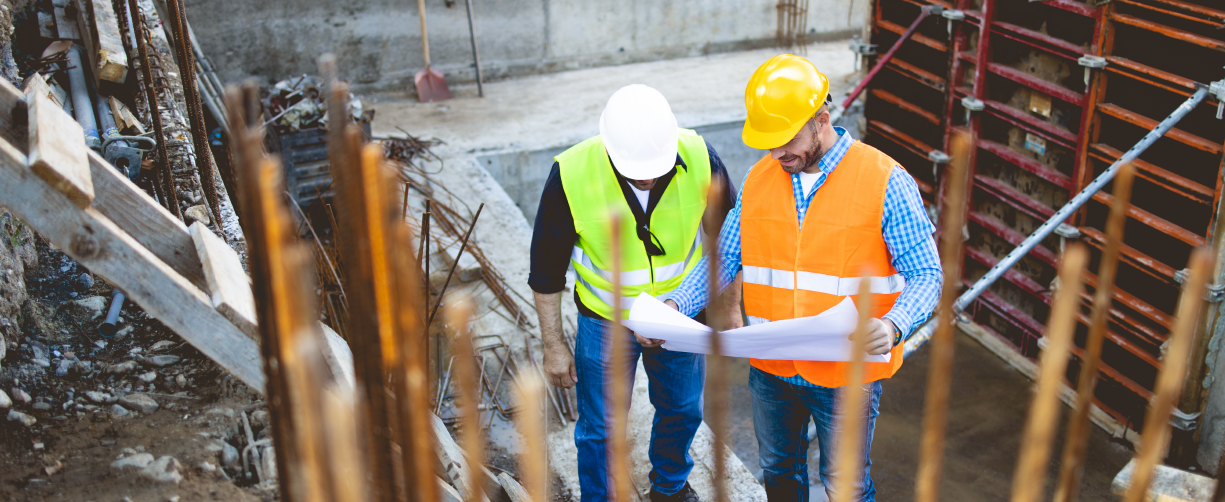An effective management of the building site – Site preparation

Site preparation is the first step of the construction process on site. The professionally prepared building site means safer and more productive working environment. The principal contractor is obliged to prepare the workplace and provide welfare facilities before the site works. In some projects the works specification include within the work scope the site preparation requirements.
Step by step guide
1/. Site survey
The preparation works on site will depends on the site investigation. Identify all works areas that will be required for safe construction:
- Construction area
- Extra workspace area
- Storage and contractor yards
- Delivery area
- Access Roads
Check all required licenses, permits and approvals. Identify site regarding any cultural heritage. Find out about the history of the site and pay attention to:
- Asbestos
- Overhead power lines or underground services
- Unusual ground conditions
- Public rights of way across the site
- Nearby roads, schools, railways
Review all issues with water usage, electricity and gas services.
2/.Site layout plan
Prepare site layout plan that will include site offices, welfare facilities, off-loading and storage area, sub-contractor facilities, car parking, entrances, temporary roads, pedestrians access, temporary services – electricity, water, gas, drainage, IT installations, site security systems. Identify safety hazards.
3/.Site fencing
Install an appropriate site fencing to secure the construction site and the neighbouring properties. This will protect from construction works dangers or from vandalism and theft.
- heavy duty and anti-climb fencing panels
- timber hoarding (recommended)
- steel hoarding
Take into consideration the access point, the driveway and off-loading area.
4/. Welfare facilities
Provide access to toilets and washing facilities. Establish the area for preparing and consuming meals and the changing area. This should be kept warm and clean. Also supply the drinking water.
5/.Site logistic
Consider preparation of traffic management plan which will include workforce, machinery, waste collection and materials delivery on site.
- Office and welfare accommodation
- Tools and plant storage
- Unloading area (forklift or manual) – consider site delivery time restrictions to limit the volume of deliveries per day. Apply the materials transportation plan within the building site.
6/. Site signing – safety and informative signs
In accordance with the law, all sites are legally required to display the current HSE health and safety poster. The poster and leaflets are available to buy from HSE website. Apart from that provide proper safety signs which conform to Health and Safety Regulations. Signs warn of building site dangers and are the essential part of the construction site Health and Safety policy. For the smaller domestic projects like extensions or refurbishments all warning might be included on one display sign. For larger projects, more comprehensive signage is required showing fire escape routes, first aid and fire points, evacuation plans, workers and visitors’ identification points, deliveries points. Moreover, a range of specific hazard signage adequate to each site area is obligatory. There should also be welfare signage for canteen, changing rooms, toilets, and site offices. It is advised to install a board easily accessed to put plans and highlight risks for particular day or week. Additionally, on the larger projects the traffic and warning direction signs should be used as per the local authority requirements, to avoid chaos and disturbance on roads.
Prohibition signs (red) – stop, no entry, no parking, no smoking, etc.
Mandatory signs (blue)- eye protection, ear protection, high visibility clothing, hard hats must be worn, etc.
Warning signs (yellow)- danger, asbestos, high voltage, work overhead, etc.
Safe condition (green)- fire exit, first aid, etc.
Fire equipment signs- fire alarm, hydrant, etc.
Signs should be displayed on hoarding, entrance points and various locations on the site. Additionally there should be informative boards describing the project and contractor- including the site manager contact details, etc. It is convenient to add the QR code, so interested parties can access all information quickly.
7/. Site security
The tender specification might require additional protection like CCTV cameras or security.
8/. Site cleaning
Prior to the commencement of the building site cleaning, it is advised to obtain the photo record of the condition of the property, including third party fencing, existing trees or any cultural heritage.
The site cleaning is a part of enabling works that might also involve tree protection, excavation of ground obstructions, disconnection of existing services or provision of access ramps. During the site cleaning the road closures, arrangements and other restrictions can be done. Moreover, if required scaffolding can be installed and third party properties secured or fenced.
The standards for the safety of ladders, stairways, openings, etc. should be established. Also, the waste disposal areas with skips should be arranged.
9/. Provide equipment and materials
Provide all essential equipment for workers, including safety clothing and accessories. Arrange the delivery of all materials, tools and plant necessary to conduct the site cleaning, preparation and then to commence works.
10/. Contractor mobilisation works
Before works start contractor should provide workers with the site induction. It is also obligatory to prepare the construction phase plan and make the waste management plan.
The construction phase plan is required under the Construction (Design and Management) Regulations 2015 (CDM 2015) for every construction project. Prepare the risk assessments and health and safety policy and notify Health and Safety Executive about more complex projects. The Site Waste Management Plans Regulations oblige the client (other than domestic clients) and the principal contractor for any construction project (also maintenance and alteration works) with an approximated cost of more than £300,000 to establish the site waste management plan. Such plan involves the estimations of how much waste will be reused on site or removed for recycling or disposal. Put in place measures to deal with dangerous substances. The safe working procedures for dealing, storing, handling and disposal of hazardous waste should be established, for instance using Hazibags, which are approved by the Consideration Construction Scheme.
It is highly recommended to register with the Consideration Construction Scheme, which improve the image of the construction site. It is recognised scheme in the sector that offers the independent assessment of the site. Construction sites are monitored against the Code of Considerate Practise and contractors are supervised, advised and assessed during the project about the site management. The main aims of the scheme are care about the appearance, respect for the community and environment, care about health and safety standards and provision of high standards for the workforce. The certification is provided at the end of project, which is a valuable reference for future.
Lastly, within at least three days before the works commencement, the principal contractor should inform the local authority or an approved inspector of the intention to start works and procedures for inspections should be agreed.
Source: HSE






